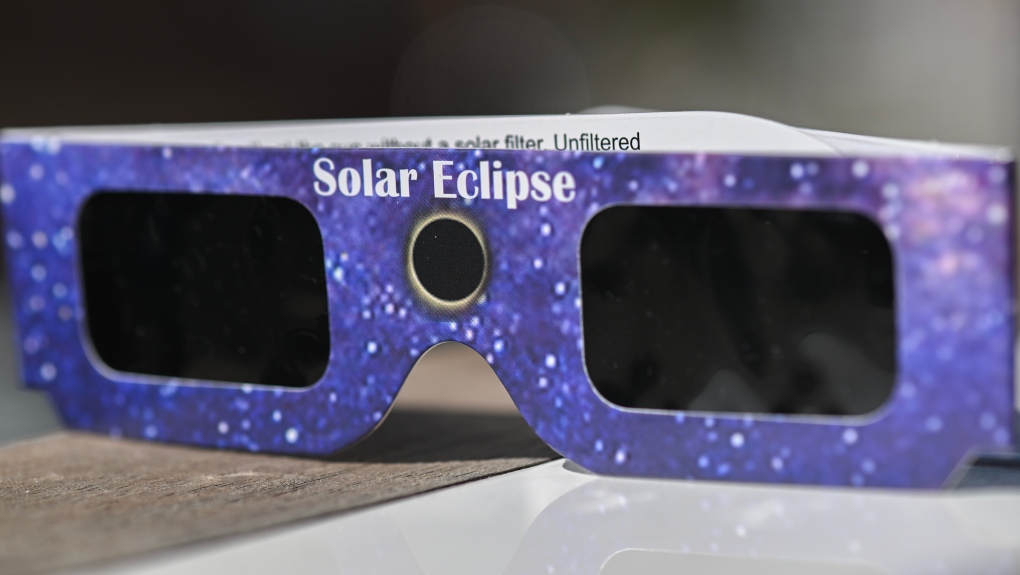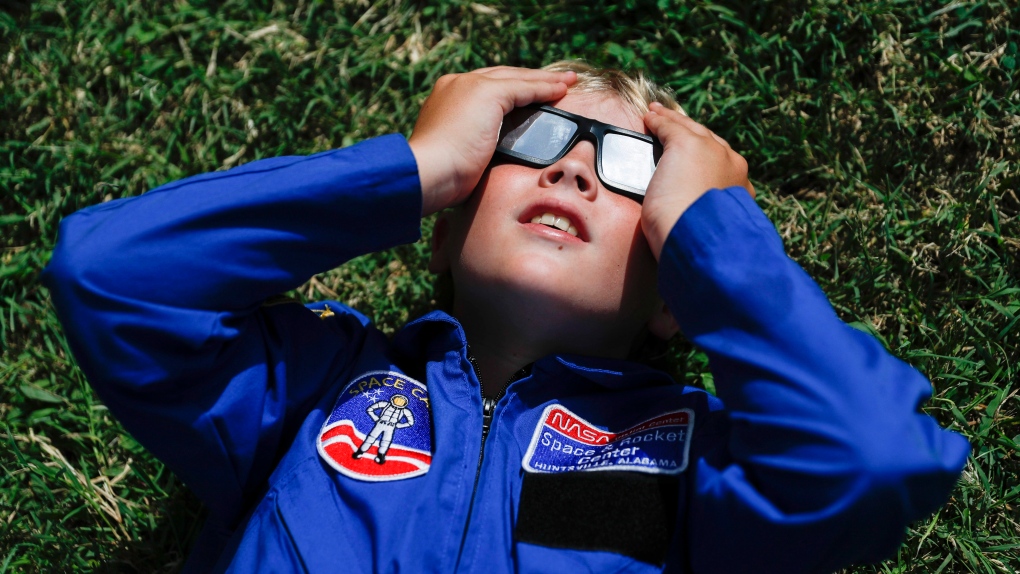Millions of people in Canada’s eastern provinces will have the chance to witness a rare total solar eclipse on Monday. But even if you’re in the West, you can watch it all live here.
The April 8 eclipse will occur over a large swath of North America and during the brief period when the moon totally covers the sun, day transforms to night with a show of streamers and magnetic loops dancing around the sun.
Watch CTVNews.ca on Monday ahead of the 2 p.m. EDT eclipse as we stream multiple live channels, dedicated to giving you many vantage points to watch the solar eclipse safely.
Here’s everything you need to know to experience the rare celestial event.
What is a total solar eclipse?
In a total solar eclipse, the moon passes between the sun and Earth, entirely covering the face of the sun along a small path of our planet’s surface. This is called the “path of totality” and the daytime sky turns dark, akin to dusk or dawn.
In places along the path of totality, people will be able to view the sun’s corona, the star’s outer atmosphere, which typically is not visible because of solar brightness.
What happens during a total solar eclipse?
The moon will be in a direct line between the sun and the Earth, creating a dark, quickly moving shadow on the face of our planet. That particular type of shadow is called an umbra.
For those watching from within the moon’s so-called path of totality, the sun’s rays will be completely blocked, plunging the surrounding landscape into darkness for a short time.
Observers outside that path will see a partial eclipse, as the moon will block part of the sun, creating a lighter shadow known as a penumbra.
Be sure to watch for about an hour before and after totality to see the moon fully transit in front of the sun. It is only safe to remove eye protection in the brief period the sun is blocked.
Where will the eclipse be visible in Canada?
All of the provinces in eastern Canada will experience a total solar eclipse on April 8, 2024.
Depending on your location in Canada, the total eclipse will be visible for anywhere from just a few seconds to approximately three-and-a-half minutes near the centre of the path of totality. Those in cities just outside its path like London, Toronto, Ottawa, Laval, Quebec, Moncton, Charlottetown and St. John’s still have reason to look up.
What time is the solar eclipse?
According to NASA’s calculations, the total eclipse will begin to peak in Canada in the minutes before 3:15 pm local time for communities near the north shore of Lake Erie in southwestern Ontario. Minutes later, it will be visible near Lake Ontario – but not in Toronto – and then southern Quebec. After 4:30 pm Atlantic daylight time, central New Brunswick and then western P.E.I. will see the full display before it appears over Newfoundland after 5:10 local time.
Canadian towns and cities with clear views include Port Dover, Niagara Falls, Hamilton, Belleville, Kingston, Cornwall, Sherbrooke, Saint-Georges, Fredericton and Miramichi. Parts of southern Montreal will be able to glimpse the phenomena, but likely not the northern part of the island. In Nova Scotia, just the northernmost tip of Cape Breton Island will quickly see the total eclipse around 4:40 pm local time, according to the website eclipse2024.org
What does a solar eclipse look like?
Robert Cockcroft, assistant professor at the department of physics and astronomy at McMaster University in Hamilton, Ont. described the experience of seeing a total solar eclipse in Nashville on Aug. 21, 2017.
He said it was more like a sunrise, or a sunset with colours all around the horizon, rather than being completely dark.
“You’ll see like a little Pac-Man shape starting to appear as the moon progressively moves more and more in front of the sun. The sun will start to appear more and more crescent-like through your eclipse glasses,” Cockcroft said in a video interview with CTVNews.ca. “It will get so dark in the sky that you’ll be able to see … Venus and Jupiter on either side of the sun and you’ll be able to see some of the brightest stars in the sky.”
The moon covers the sun during a solar eclipse in Piedra del Aguila, Argentina, Monday, Dec. 14, 2020. (AP Photo/Natacha Pisarenko)
What is the path of the solar eclipse?
According to NASA, the solar eclipse will begin over the South Pacific, with its path reaching Mexico’s Pacific coast at around 11:07 a.m. Pacific Time before entering the United States in Texas.
Its path then takes it through Oklahoma, Arkansas, Missouri, a tiny piece of Tennessee, Illinois, Kentucky, Indiana, Ohio, a tiny piece of Michigan, Pennsylvania, New York, Vermont, New Hampshire and Maine.
The path then enters Canada in Ontario and journeys through Quebec, New Brunswick, Prince Edward Island and Cape Breton, exiting continental North America on the Atlantic coast of Newfoundland, Canada, at 5:16 p.m. Newfoundland Time. A partial eclipse is due to be visible for people in all 48 contiguous U.S. states.
- Here’s when you can see the eclipse in Ontario and Quebec
- Here’s when you can see the eclipse in New Brunswick
How long will the total eclipse last?
At most, four minutes 28 seconds at the centre of the path of total darkness over northern Mexico. As the shadow moves eastward, it will pick up speed. As a result, the duration of totality in the centre of the path will decrease from a maximum of three minutes 38 seconds on the Canadian side of Lake Erie to as little as two minutes 54 seconds in northeastern Newfoundland, according to Eclipse2024.org.
The duration drops off the farther you stray from the path’s centre line.
Where are some of the best places to see the eclipse?
Some major cities and their metropolitan areas lay within or near the path of totality. Some of these include: Mazatlan and Torreon in Mexico; San Antonio, Austin, Waco, Fort Worth and Dallas in Texas; Little Rock in Arkansas; St. Louis in Missouri; Louisville in Kentucky; Indianapolis in Indiana; Dayton, Columbus, Toledo and Cleveland in Ohio; Detroit in Michigan; Erie in Pennsylvania; Buffalo, Rochester and Syracuse in New York; and Hamilton, Toronto and Montreal in Canada.
How can I view the eclipse safely?
To avoid damaging your eyes, proper gear is essential. Glasses with special dark lenses certified for solar viewing with an ISO 12312-2 international standard are the simplest option and relatively inexpensive online, including from the Royal Astronomical Society of Canada. NASA and the American Astronomical Society( also offer recommendations. Similar filters are also available for cameras and smartphones.
 A pair of NASA approved Solar Eclipse glasses are shown in Montreal, Tuesday, April 2, 2024. THE CANADIAN PRESS/Graham Hughes
A pair of NASA approved Solar Eclipse glasses are shown in Montreal, Tuesday, April 2, 2024. THE CANADIAN PRESS/Graham Hughes
If you can’t get glasses, the Canadian Space Agency provides instructions for making a DIY solar eclipse projector) with little more than a cardboard box, paper, scissors, aluminum foil, a pin and tape. These act like pinhole cameras and will show you a small projection of the eclipse inside the box. Welding helmets with shade 12 or higher are also safe, according to NASA. No matter how dark, sunglasses just won’t cut it.
Bill Archer, a mission specialist with the Canadian Space Agency, says there’s also good reason to look down during a solar eclipse to watch shadows transform like thousands of pinhole cameras.
Do not look at the sun directly. NASA says the only safe time to directly view the sun is during the brief phase of totality when the moon fully covers it.
Sunscreen is also recommended to protect your skin since you will be exposed to the sun.
Are solar eclipses rare?
Solar eclipses appear once or twice every year somewhere on the planet, according to NASA. Most locations typically wait between 400 and 1,000 years for a repeat performance.
Nova Scotia, however, was visited by total solar eclipses in 1970 and again in 1972. And next month’s eclipse will also track across the northern tip of Cape Breton.
Since 1963, Canadians have witnessed five total solar eclipses, though the one in 2008 tracked across the upper reaches of the Arctic.
When is the next solar eclipse after 2024?
The most recent total solar eclipse in Canada occurred in Aug. 2008, but was only visible in the country’s far north. Before that, Canadians were last treated to a total solar eclipse in Feb. 1979, with Manitoba getting the most spectacular view. After this April, the next Canadian total solar eclipse will occur in Aug. 2044 over parts of Alberta, B.C. and the territories. Atlantic Canada will have its next chance in May 2079.
An annular solar eclipse occurs when the moon is further away from earth and blocks less of the sun, leaving a larger fiery ring. A May 1994 annular solar eclipse was visible in Ontario and Nova Scotia. The next annular solar eclipse will occur over Canada in June 2048.
With files from The Canadian Press and Reuters




